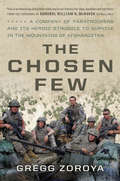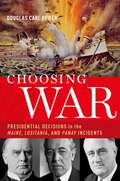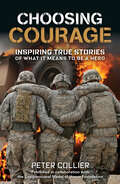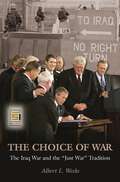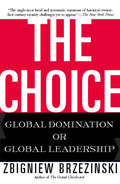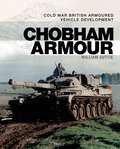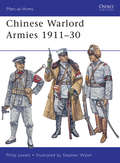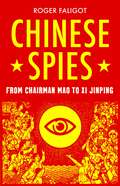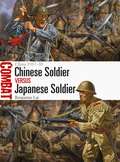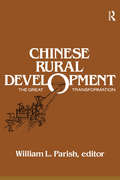- Table View
- List View
Chris Ryan Extreme: Faster, Grittier, Darker, Deadlier (Chris Ryan Extreme #1)
by Chris RyanThe first book in the Chris Ryan Extreme series. Former SAS Warrant Officer Joe Gardner has fought the Regiment's deadliest enemies, in some of the most desolate places on earth. And he's always won. Now he's about to face his toughest challenge yet. After losing his hand whilst on a covert operation in Afghanistan, Gardner is forced to stand down from active duty. Now he lives off the grid. But trouble finds him in the shape of a phone call from an old friend. Ex-Regiment legend John Bald is trapped in a bullet-ridden favela in Rio de Janeiro and a violent gang is out to kill him. Unless Gardner helps, Bald is a dead man. What begins as a simple rescue mission soon descends into a desperate struggle for survival as Gardner finds himself caught up in a conceit that stretches from the slums of Brazil to the frozen steppes of Siberia. Stalked by elusive MI6 agents and ruthless ex-Blades, Gardner must draw on all his training and instincts to hunt down the hardest target of all - before disaster strikes... The Chris Ryan Extreme books take you even further into the heart of the mission with more extreme action, more extreme language and more extreme pace. Like Call of Duty or Medal of Honor, you'll feel part of the team. Chris Ryan Extreme: Hard Target has previously been published as four separate shorter missions. Now in one ebook to keep you at the centre of the action.
Chris Ryan Extreme: The second book in the gritty Extreme series (Chris Ryan Extreme #2)
by Chris RyanThe second book in the Chris Ryan Extreme series. Former SAS hero John Bald is a man at war with himself and fighting a losing battle with the bottle. But then he is reluctantly thrust back into battle...In the race to develop ever more powerful weapons, technology has become the new frontline in global terrorism. And when one of America's most cutting-edge defence contractors suspects a sleeper cell operating in its midst, the Firm reaches out to its most cold-blooded son. Bald's mission: kill the sleeper before they can smuggle top-secret weaponry into the hands of the West's deadliest enemies.But the mission goes sideways, and Bald is the fall guy. Now he must pursue the sleeper from the ghettos of Florida to the war-torn streets of Tripoli, in a relentless hunt for the technology and the truth. Shadowed every step of the way by a ruthless CIA hitman, Bald soon finds that the lines between friend and enemy are blurred, and he'll have to call on all his warrior instincts to stay alive...The Chris Ryan Extreme books take you even further into the heart of the mission with even more extreme action, more extreme language and more extreme pace. Like Call of Duty or Medal of Honor, you'll feel part of the team. Chris Ryan Extreme: Night Strike has previously been published as four separate shorter missions. Now combined in one ebook to keep you at the centre of the action.
The Chosen Few: A Company of Paratroopers and Its Heroic Struggle to Survive in the Mountains of Afghanistan
by Gregg ZoroyaThe never-before-told story of one of the most decorated units in the war in Afghanistan and its fifteen-month ordeal that culminated in the 2008 Battle of Wanat, the war's deadliestA single company of US paratroopers--calling themselves the "Chosen Few"--arrived in eastern Afghanistan in late 2007 hoping to win the hearts and minds of the remote mountain people and extend the Afghan government's reach into this wilderness. Instead, they spent the next fifteen months in a desperate struggle, living under almost continuous attack, forced into a slow and grinding withdrawal, and always outnumbered by Taliban fighters descending on them from all sides.Month after month, rocket-propelled grenades, rockets, and machine-gun fire poured down on the isolated and exposed paratroopers as America's focus and military resources shifted to Iraq. Just weeks before the paratroopers were to go home, they faced their last--and toughest--fight. Near the village of Wanat in Nuristan province, an estimated three hundred enemy fighters surrounded about fifty of the Chosen Few and others defending a partially finished combat base. Nine died and more than two dozen were wounded that day in July 2008, making it arguably the bloodiest battle of the war in Afghanistan.The Chosen Few would return home tempered by war. Two among them would receive the Medal of Honor. All of them would be forever changed.
Choosing War: Presidential Decisions in the Maine, Lusitania, and Panay Incidents
by Douglas Carl PeiferThroughout US history, presidents have had vastly different reactions to naval incidents. Though some incidents have been resolved diplomatically, others have escalated to outright war. What factors influence the outcome of a naval incident, especially when calls for retribution mingle with recommendations for restraint? Given the rise of long range anti-ship and anti-air missile systems, coupled with tensions in East Asia, the Persian Gulf, and the Black and Baltic Seas, the question is more relevant than ever for US naval diplomacy. In Choosing War, Douglas Carl Peifer compares the ways in which different presidential administrations have responded when American lives were lost at sea. He examines in depth three cases: the Maine incident (1898), which led to war in the short term; the Lusitania crisis (1915), which set the trajectory for intervention; and the Panay incident (1937), which was settled diplomatically. While evaluating Presidents William McKinley, Woodrow Wilson, and Franklin Delano Roosevelt's responses to these incidents, Peifer lucidly reflects on the options they had available and the policies they ultimately selected. The case studies illuminate how leadership, memory, and shifting domestic policy shape presidential decisions, providing significant insights into the connections between naval incidents, war, and their historical contexts. Rich in dramatic narrative and historical perspective, Choosing War offers an essential tool for confronting future naval crises.
Choosing War: Presidential Decisions in the Maine, Lusitania, and Panay Incidents
by Douglas Carl PeiferThroughout US history, presidents have had vastly different reactions to naval incidents. Though some incidents have been resolved diplomatically, others have escalated to outright war. What factors influence the outcome of a naval incident, especially when calls for retribution mingle with recommendations for restraint? Given the rise of long range anti-ship and anti-air missile systems, coupled with tensions in East Asia, the Persian Gulf, and the Black and Baltic Seas, the question is more relevant than ever for US naval diplomacy. In Choosing War, Douglas Carl Peifer compares the ways in which different presidential administrations have responded when American lives were lost at sea. He examines in depth three cases: the Maine incident (1898), which led to war in the short term; the Lusitania crisis (1915), which set the trajectory for intervention; and the Panay incident (1937), which was settled diplomatically. While evaluating Presidents William McKinley, Woodrow Wilson, and Franklin Delano Roosevelt's responses to these incidents, Peifer lucidly reflects on the options they had available and the policies they ultimately selected. The case studies illuminate how leadership, memory, and shifting domestic policy shape presidential decisions, providing significant insights into the connections between naval incidents, war, and their historical contexts. Rich in dramatic narrative and historical perspective, Choosing War offers an essential tool for confronting future naval crises.
Choosing Courage: Inspiring True Stories of What It Means to Be a Hero
by Peter CollierHow does an ordinary person become a hero? It happens in a split second, a moment of focus and clarity, when a choice is made. Here are the gripping accounts of Medal of Honor recipients who demonstrated guts and selflessness on the battlefield and confronted life-threatening danger to make a difference. There are the stories of George Sakato and Vernon Baker—both of whom overcame racial discrimination to enlist in the army during World War II (Sakato was a second-generation Japanese American, Baker an African American) and went on to prove that heroes come in all colors—and Clint Romesha, who led his outnumbered fellow soldiers against a determined enemy to prevent the Taliban from taking over a remote U.S. Army outpost in Afghanistan. Also included are civilians who have been honored by the Congressional Medal of Honor Foundation for outstanding acts of bravery in crisis situations, from a school shooting to the 9/11 attacks on the World Trade Center. Adding depth and context are illuminating essays on the combat experience and its aftermath, covering topics such as overcoming fear; a mother mourning the loss of her son; and &“surviving hell&” as a prisoner of war.
Choke Point
by Don PendletonThe Stony Man team of special operators stands ready to go into ultra-covert action whenever the President needs a specific brand of below-the-radar expertise.
The Choice of War: The Iraq War and the Just War Tradition (The Ethics of American Foreign Policy)
by Albert L. WeeksA longtime scholar of the Cold War deftly weaves together the tradition of "just war" and an examination of current events to show how the time-honored concepts of jus ad bellum (justice of war) and jus in bello (justice in war) apply to the U.S. military involvement in Iraq.This timely analysis of President George W. Bush's foreign policy deals with the cornerstone of his administrations—the "war on terror"—as implemented in Afghanistan, Iraq, Guantanamo Bay, and at Abu Ghraib prison. The Choice of War: The Iraq War and the "Just War" Tradition discusses NSS 2002, the national security statement that became the blueprint for the Bush Doctrine. It explains the differences and similarities between preventive and pre-emptive war and explores the administration's justification of the necessity of the March 2003 invasion. Finally, it analyzes the conduct of the war, the occupation, and the post-occupation phases of the conflict.In evaluating the Bush Doctrine, both as declared strategy and as implemented, Albert L. Weeks asks whether going it virtually alone in the global struggle against 21st-century terrorism should be incorporated permanently into American political and military policy. Answering no, he suggests an alternative to a doctrine that has isolated the United States and left the world divided.
The Choice of War: The Iraq War and the Just War Tradition (The Ethics of American Foreign Policy)
by Albert L. WeeksA longtime scholar of the Cold War deftly weaves together the tradition of "just war" and an examination of current events to show how the time-honored concepts of jus ad bellum (justice of war) and jus in bello (justice in war) apply to the U.S. military involvement in Iraq.This timely analysis of President George W. Bush's foreign policy deals with the cornerstone of his administrations—the "war on terror"—as implemented in Afghanistan, Iraq, Guantanamo Bay, and at Abu Ghraib prison. The Choice of War: The Iraq War and the "Just War" Tradition discusses NSS 2002, the national security statement that became the blueprint for the Bush Doctrine. It explains the differences and similarities between preventive and pre-emptive war and explores the administration's justification of the necessity of the March 2003 invasion. Finally, it analyzes the conduct of the war, the occupation, and the post-occupation phases of the conflict.In evaluating the Bush Doctrine, both as declared strategy and as implemented, Albert L. Weeks asks whether going it virtually alone in the global struggle against 21st-century terrorism should be incorporated permanently into American political and military policy. Answering no, he suggests an alternative to a doctrine that has isolated the United States and left the world divided.
A Choice of Enemies: America Confronts The Middle East
by Lawrence FreedmanPrize-winning historian Lawrence Freedman takes an exceptionally clear-eyed look at America’s strategic predicament in the Middle East, over the past 30 years. The United States is locked into three prolonged conflicts without much hope of early resolution. Iran is pursuing a nuclear programme; the aftermath of the overthrow of Saddam Hussein has seen unrelenting intercommunal violence; and the Taliban have got back into Afghanistan. Lawrence Freedman teases out the roots of each engagement over the last thirty years and demonstrates with clarity and scholarship the influence of these conflicts upon each other. The story is complex and often marked by great drama. First, the countries in dispute with America are not themselves natural allies; second, their enmity was not, at first, America’s choice. Third, the region’s problems cannot all be traced to the Arab-Israeli dispute. Unique in its focus, this book will offer not only new revelations but also remind us of what has been forgotten or has never been put in context.
The Choice: Global Domination or Global Leadership
by Zbigniew BrzezinskiAmerican power and a pervasive globalization are the central realities of today's world, and the source of its thorniest dilemmas. Yet while America's unprecedented might should be the source of global security, Americans today feel less secure than ever. Globalization promotes American dominance even as it breeds anti-American resentment. In The Choice, former National Security Advisor Zbigniew Brzezinski addresses the historic choice facing America at this very moment: Will it strive to dominate the world, or lead it? Reminding us that American dominance should not be confused with omnipotence, Brzezinski shows how America's well-being and the world's are entwined, and that America must find a way to be both guarantor of global security and promoter of the global common good."When it comes to what might be called the 'philosophy' of foreign policy-the relationship of U.S. power and policy to broader historical and cultural trends-no statesman of Brzezinski's generation is in his league.... A tour d'horizon of U.S. foreign policy [that] discusses the inevitable contradictions and tensions that enmesh a democratic society that is also a global hegemon, criticizes the Bush administration, and articulates his own vision of the way forward-all in a little over 200 pages. Even those who do not accept Brzezinski's critique of the Bush administration will admire the sagacity of his views; for Democrats attempting to assemble a serious and thoughtful alternative to Bush's foreign policy, The Choice is indispensable."-Walter Russell Mead, Foreign Affairs
Chocolate Girls (Chocolate Girls #1)
by Annie MurrayIn Annie Murray's bestselling Chocolate Girls, three very different women work together at Cadbury's Bournville factory, and their lives become entwined by war and work – and a child called David.Edie marries young to escape her unhappy family home. Widowed at nineteen and, after losing her child from the marriage, she faces the war grieving and lonely. Then one night during the Blitz, an infant mysteriously abandoned during the bombing is handed into her care . . . Ruby, meanwhile, doesn't want to be left behind in the wedding stakes and settles for marriage with Frank.Finally there's Janet, kind-hearted and susceptible to male charm, who is hurt desperately by an affair with a married man.David, the child who steals Edie's heart as she brings him up through a time none of them will ever forget, is the love of all their lives. And when David is old enough to wonder who he really is, he leads Edie through struggle and heartache to a life and love she would never have dreamed of . . . Chocolate Girls is followed by the captivating sequel, The Bells of Bournville Green.
Chobham Armour: Cold War British Armoured Vehicle Development
by William SuttieA comprehensive overview of the work of the Military Vehicles Research and Development Establishment on Chobham Common, which provided armoured vehicles for the British Army from 1945 to its close in 2004.Through much of World War II British tanks and armoured vehicles were outmatched by the German tanks they encountered and this led to the British Army placing much emphasis on ensuring that the same situation would not arise again if the Cold War turned hot. The task of developing the Main Battle Tanks and supporting armoured vehicles to out-range and quickly destroy the Soviet threat fell to the scientists and engineers at the Fighting Vehicle Research and Development Establishment on Chobham Common near to Chertsey. It was the design authority for all British Military vehicles for most of the period.Military vehicle and equipment expert William Suttie draws extensively on official MOD reports to tell the story of the development of the British Cold War armour, such as the Centurion, Chieftain, Challenger, and many other wheeled and tracked armour vehicles that served the British Army of The Rhine. The vehicles developed at the Chertsey site were never used for their intended purpose on the plains of North-west Germany, but have proved their worth in British operations in places like Korea, Bosnia, Kuwait, Iraq and Afghanistan, as well as in the hands of other users around the world.Fully illustrated with photographs, schemes and drawings, including some that have never been published before, this is a unique detailed overview of the development of all post-war British armoured vehicles.
Chobham Armour: Cold War British Armoured Vehicle Development
by William SuttieA comprehensive overview of the work of the Military Vehicles Research and Development Establishment on Chobham Common, which provided armoured vehicles for the British Army from 1945 to its close in 2004.Through much of World War II British tanks and armoured vehicles were outmatched by the German tanks they encountered and this led to the British Army placing much emphasis on ensuring that the same situation would not arise again if the Cold War turned hot. The task of developing the Main Battle Tanks and supporting armoured vehicles to out-range and quickly destroy the Soviet threat fell to the scientists and engineers at the Fighting Vehicle Research and Development Establishment on Chobham Common near to Chertsey. It was the design authority for all British Military vehicles for most of the period.Military vehicle and equipment expert William Suttie draws extensively on official MOD reports to tell the story of the development of the British Cold War armour, such as the Centurion, Chieftain, Challenger, and many other wheeled and tracked armour vehicles that served the British Army of The Rhine. The vehicles developed at the Chertsey site were never used for their intended purpose on the plains of North-west Germany, but have proved their worth in British operations in places like Korea, Bosnia, Kuwait, Iraq and Afghanistan, as well as in the hands of other users around the world.Fully illustrated with photographs, schemes and drawings, including some that have never been published before, this is a unique detailed overview of the development of all post-war British armoured vehicles.
Chinese Warlord Armies 1911–30 (Men-at-Arms)
by Stephen Walsh Philip JowettDefeated in the Sino-Japanese War 1894–95 and the Boxer Rebellion of 1900, Imperial China collapsed into revolution and a republic was proclaimed in 1912. From the death of the first president in 1916 to the rise of the Nationalist Kuomintang government in 1926, the differing regions of this vast country were ruled by endlessly forming, breaking and re-forming alliances of regional generals who ruled as 'warlords'. These warlords acted essentially as local kings and much like Sengoku-period Japan, fewer, larger power-blocks emerged, fielding armies hundreds of thousands strong. In the midto late 1920s some of these regional warlords. This book will reveal each great warlord as well as the organization of their forces which acquired much and very varied weaponry from the west including the latest French air force bombers. They were also joined by Japanese, White Russian and some Western soldiers of fortune which adds even more colour to a fascinating and oft-forgotten period.
Chinese Warlord Armies 1911–30 (Men-at-Arms #463)
by Stephen Walsh Philip JowettDefeated in the Sino-Japanese War 1894–95 and the Boxer Rebellion of 1900, Imperial China collapsed into revolution and a republic was proclaimed in 1912. From the death of the first president in 1916 to the rise of the Nationalist Kuomintang government in 1926, the differing regions of this vast country were ruled by endlessly forming, breaking and re-forming alliances of regional generals who ruled as 'warlords'. These warlords acted essentially as local kings and much like Sengoku-period Japan, fewer, larger power-blocks emerged, fielding armies hundreds of thousands strong. In the midto late 1920s some of these regional warlords. This book will reveal each great warlord as well as the organization of their forces which acquired much and very varied weaponry from the west including the latest French air force bombers. They were also joined by Japanese, White Russian and some Western soldiers of fortune which adds even more colour to a fascinating and oft-forgotten period.
Chinese Soldier vs Japanese Soldier: China 1937–38 (Combat)
by Johnny Shumate Benjamin LaiIn July 1937, the Marco Polo Bridge Incident sparked a bloody conflict between Chinese and Japanese forces that would rage across China and beyond for more than eight years. The two sides' forces brought very different strengths and limitations to the conflict. In 1937 China was divided into factions, each controlled by warlords with independent forces, and there was no unified Chinese army. In order to fight the Japanese Chiang Kai-shek, the nominal leader of Nationalist China, was compelled to do deals with these regional powers. For their part, the Japanese employed ground forces broadly comparable to those fielded by Western powers, including modern artillery and tanks. Featuring specially commissioned artwork and drawing upon an array of sources, this study investigates the origins, training, doctrine and armament of the Chinese and Japanese forces who fought in the opening stages of the Second Sino-Japanese War.
Chinese Soldier vs Japanese Soldier: China 1937–38 (Combat)
by Johnny Shumate Benjamin LaiIn July 1937, the Marco Polo Bridge Incident sparked a bloody conflict between Chinese and Japanese forces that would rage across China and beyond for more than eight years. The two sides' forces brought very different strengths and limitations to the conflict. In 1937 China was divided into factions, each controlled by warlords with independent forces, and there was no unified Chinese army. In order to fight the Japanese Chiang Kai-shek, the nominal leader of Nationalist China, was compelled to do deals with these regional powers. For their part, the Japanese employed ground forces broadly comparable to those fielded by Western powers, including modern artillery and tanks. Featuring specially commissioned artwork and drawing upon an array of sources, this study investigates the origins, training, doctrine and armament of the Chinese and Japanese forces who fought in the opening stages of the Second Sino-Japanese War.
Chinese Security Policy: Structure, Power and Politics
by Robert RossThis volume provides a coherent and comprehensive understanding of Chinese security policy, comprising essays written by one of America's leading scholars. Chinese Security Policy covers such fundamental areas as the role of international structure in state behavior, the use of force in international politics (including deterrence, coercive diplomacy, and war), and the sources of great-power conflict and cooperation and balance of power politics, with a recent focus on international power transitions. The research integrates the realist literature with key issues in Chinese foreign policy, thereby placing China’s behaviour in the larger context of the international political system. Within this framework, Chinese Security Policy considers the importance of domestic politics and leadership in Chinese policy making. This book examines how Chinese strategic vulnerability since U.S.-China rapprochement in the early 1970s has compelled Beijing to seek cooperation with the United States and to avoid U.S.-China conflict over Taiwan. It also addresses the implications of the rise of China for the security of both United States and of Chinese neighbors in East Asia, and considers the implications of China’s rise for the regional balance of power and the emerging twenty-first century East Asian security order. This book will be of great interest to all students of Chinese Security and Foreign Policy, Chinese and Asian Politics, US foreign policy and International Security in general.
Chinese Security Policy: Structure, Power and Politics
by Robert RossThis volume provides a coherent and comprehensive understanding of Chinese security policy, comprising essays written by one of America's leading scholars. Chinese Security Policy covers such fundamental areas as the role of international structure in state behavior, the use of force in international politics (including deterrence, coercive diplomacy, and war), and the sources of great-power conflict and cooperation and balance of power politics, with a recent focus on international power transitions. The research integrates the realist literature with key issues in Chinese foreign policy, thereby placing China’s behaviour in the larger context of the international political system. Within this framework, Chinese Security Policy considers the importance of domestic politics and leadership in Chinese policy making. This book examines how Chinese strategic vulnerability since U.S.-China rapprochement in the early 1970s has compelled Beijing to seek cooperation with the United States and to avoid U.S.-China conflict over Taiwan. It also addresses the implications of the rise of China for the security of both United States and of Chinese neighbors in East Asia, and considers the implications of China’s rise for the regional balance of power and the emerging twenty-first century East Asian security order. This book will be of great interest to all students of Chinese Security and Foreign Policy, Chinese and Asian Politics, US foreign policy and International Security in general.
Chinese Rural Development: The Great Transformation
by William L. ParishThis text examines the Pacific War, the Korean War and the Vietnam War, from the perspective of those who fought the wars and lived through them. The relationship between history and memory informs the book, and each war is relocated in the historical and cultural experiences of Asian countries.
Chinese Rural Development: The Great Transformation
by William L. ParishThis text examines the Pacific War, the Korean War and the Vietnam War, from the perspective of those who fought the wars and lived through them. The relationship between history and memory informs the book, and each war is relocated in the historical and cultural experiences of Asian countries.
The Chinese People’s Liberation Army since 1949: Ground Forces (Elite)
by Adam Hook Benjamin LaiThe Chinese People's Liberation Army (PLA) is the largest army in the world. China is predicted to be on the brink of overtaking the USA as the world's largest economy, and China's military capabilities and global ambitions are the single greatest long-term pre-occupation of Western governments. The PLA has progressed steadily – if slowly – since its creation in 1949, from a mass army of unsophisticated infantry limited to 'human wave' tactics into a highly sophisticated force with wide capabilities. The most recent reforms (1989 to the present day) have been made possible by massive economic liberalization, and have seen not only the modernization of all the armed forces but the beginnings of global outreach, even including Chinese participation in UN peace-keeping missions to Africa, the Middle East, and Haiti. Featuring rare photographs and specially commissioned color artwork, this study explores the developing structure, organization, equipment, appearance, and character of the Chinese People's Liberation Army from its creation until today.


